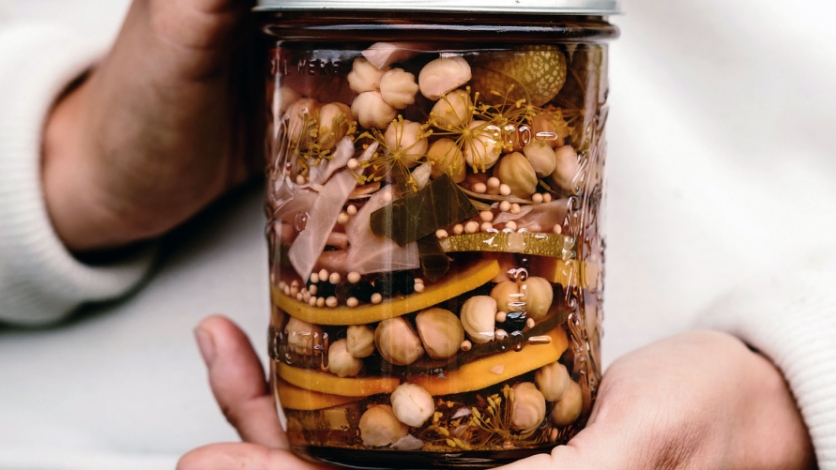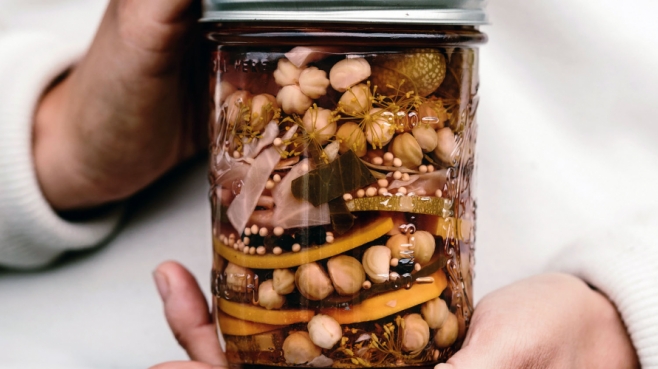Pickled Nasturtium Seed and More Tales of a Perfect Plant

Oh, the unassuming nasturtium.
So frequently flying under the radar in a world of showy gardens, nasturtium is a cultivated plant that is too easy to overlook. But once you begin keeping an eye out for this fast-spreading member of the Brassica genus, you realize just how prolific it truly is.
You’ll notice it hanging in entryways, its red, yellow and orange bell-shaped blossoms cascading over the sides of their containers. You’ll spot it running alongside buildings, those kelly green leaves facing upward like a carpet of lily pads out of the water. It’ll catch your eye in flower gardens, modestly serving as the base over which delphinium, cosmos and coneflower take center stage. You’ll find it populating raised beds, playing second fiddle to nearby strawberries, jewel-like currants and arching rhubarb stalks with their giant elephant-ear leaves.
Rarely the headliner but perpetually in the background of its more revered neighbors, it can be our instinct to discount the nasturtium. But, despite the fact that it is unlikely to show up on many people’s favorite flowers list, nasturtium is one of those rare gems of gardening—a plant with several edible parts that, if you get your timing right, can be harvested throughout the growing season. Or, to phrase it another way (and to horribly misquote The Princess Bride ), there’s a shortage of perfect plants in this world. It would be a pity to waste part of this one.
I find each of the three harvestable items from the nasturtium plant—leaves, flowers and seeds—to be versatile and delicious additions to seasonal cooking.
It is easy to sing the praises of nasturtium leaves. The peppery, arugula-like greens spice up milder lettuce mixes, make a great addition to soups and are a perfect layer in your garden lasagna. And the round, flat leaves are remarkable not only to our palates but to modern science. One only has to watch the hovering, center-stemmed leaves during a rainstorm, noting how water beads up and bounces off their surfaces, to understand why they are studied in research on fabricating waterproof materials.
Then there are the blossoms. Fiery reds and oranges, yellows and salmons, with deep centers that are a perfect fit for the long, thin beaks of one of our favorite garden visitors, the hummingbird. Slightly less peppery than the leaves, nasturtium flowers are a beautiful and tasty addition to salads and cold summertime pastas. And, much like a more delicate, less stuffable version of squash blossoms, these blooms make a perfect battered-and-fried side dish. (Though, who are we kidding? I’ve rarely met a garden edible that didn’t make an amazing battered-and-fried side dish. See also: shaggy mane mushrooms, pea pods, green tomatoes, garlic flowers, and pretty much everything else that grows.)
I look forward to nasturtium season in general, harvesting bunches of those leaves and flowers as the hot months prevail, but it’s definitely the nasturtium’s end-of-season contribution to mealtime that holds my heart—the seed.
The pepperiest part of the nasturtium plant, the seed is knock-your-socks-off strong in its raw form, bringing to mind a too-big bite of its brassica brother, horseradish. Translated from Latin, “nasturtium” means “twisted nose,” and the seeds earn that name with a punch that hits you right in your sinuses. In their pickled form, nasturtium seeds are still quite peppery, but that abrupt kick is softened. The end result is a flavorful, briny seed that is about the size of the tip of your pinky and is considered by many to be the culinary cousin to the caper.
Harvested and brined when they are still green and before they become tough, pickled nasturtium seeds (just like the flowers and leaves) are a fabulous addition to salads—especially a bread salad like panzanella—and are a great topping for your homemade pizzas. They also seriously class up a Sunday afternoon gardenside Bloody Mary, made even classier by attaching a nasturtium flower to the rim of your glass as a garnish.






